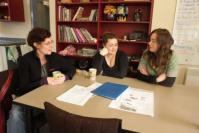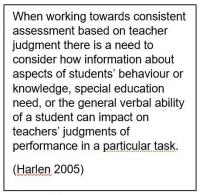You are here:
- Home »
- Moderation »
- Moderation processes »
- Meeting for moderation
Meeting for moderation

A moderation session has four goals:
- Identify similarities and differences in judgments.
- Resolve any differences.
- Achieve consistency of judgments.
- Achieve shared understanding of consistency of criteria and language used to assess.
Suggested format for a moderation session
- All teachers look at the same piece/s of work.
- Everyone reads the whole script/text/collection of evidence through without marking, commenting or discussing and assesses against the success criteria/indicators, onto a recording sheet. (See an example of a recording sheet).
- All teachers provide their judgments of piece of work.
- The coordinator records everyone’s judgments.
- The group reviews judgments and identifies areas of greatest similarity and difference.
- Teachers provide evidence and reasons for their judgments that are both similar and different. Time spent on exploring understanding of progressions of learning, or the language used in the descriptors, will lead to greater shared understanding of the assessment criteria.
- All teachers have input to the discussion.
- For each key feature, the group works towards consensus about the standard/level assigned.
- The co-ordinator records any changes in judgments as a result of discussion.
- The co-ordinator records any suggestions for improvement of future moderation sessions.
- Minutes/conclusions from the session are distributed to all teachers.
Use differences as an opportunity to deepen the knowledge base of the group
- Ask questions to clarify thinking and understanding of language.
- Explore solutions – the goal is to agree on the basis of evidence and reasoned discussion.
- Be prepared to adapt your thinking and adjust your judgment after listening to the informed ideas of others.
- Tolerate and think about different perspectives.
- Identify where more knowledge or resources are needed, and where processes could be modified.
- Get the views of all teachers.
Keep discussions focused and useful
- At the start of the process, expect and tolerate disagreement.
- Present and share your thinking in relation to evidence of key features, not just ‘gut feelings’.
- Through discussion, expose reasons for differences (expectations, interpretation of language).
- Check understanding of language used and reach shared clarity.
- Keep focused on the key features.
- Ensure all teachers’ views are heard.
- Treat it as a learning exercise, not a check to see if judgments are “right” or “wrong”.
Check for bias

Some common biases in assessing student work include:
- considering longer texts are more worthy than shorter ones
- considering neater handwriting is more worthy than untidy writing
- use of internalised, unstated standards that individual teachers have developed over time “in their heads” instead of agreed criteria based on the curriculum
- notions of being “fair” to a student by giving them the ‘benefit of the doubt’ rather than what the evidence shows
- judging work on what teachers consider students deserve based on prior knowledge or inferred judgment of student effort.
Assessment that relies on a significant degree of teacher judgment is primarily subjective. It can be useful to examine bias with teachers as “bias can result, unconsciously, from prior dealings with students based on attitude, behaviour, gender, race or disability.” (Adie, 2008).

